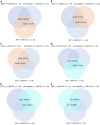Evaluating serum extra spindle pole bodies-like 1 protein vs p53 antibody for hepatitis B virus-related hepatocellular carcinoma diagnosis
- PMID: 40747232
- PMCID: PMC12308562
- DOI: 10.4254/wjh.v17.i7.108850
Evaluating serum extra spindle pole bodies-like 1 protein vs p53 antibody for hepatitis B virus-related hepatocellular carcinoma diagnosis
Abstract
Background: Hepatitis B virus (HBV) infection is a leading cause of global hepatocellular carcinoma (HCC). Conventional biomarkers such as alpha-fetoprotein (AFP) demonstrate suboptimal sensitivity and specificity. Emerging evidence suggests that serum extra spindle pole bodies like 1 (ESPL1) protein and p53 antibody may improve diagnostic accuracy.
Aim: To assess and compare the diagnostic performance of serum ESPL1 protein and p53 antibody in HBV-related HCC (HBV-HCC).
Methods: This case-control study from the First Affiliated Hospital of Guangxi Medical University enrolled 30 patients with chronic hepatitis B (CHB), 30 with HBV-related liver cirrhosis (HBV-LC), 55 with HBV-HCC, and 30 healthy controls. Serum ESPL1 protein and p53 antibody levels were quantified via ELISA. Diagnostic performance was evaluated using receiver operating characteristic (ROC) curve analysis, including sensitivity, specificity, and correlation with AFP.
Results: Serum ESPL1 protein levels progressively increased across disease stages (CHB: 89.9 ng/L; HBV-LC: 188.83 ng/L; HBV-HCC: 317.63 ng/L), with a significantly higher area under the ROC curve (AUC = 0.917) than either p53 antibody (AUC = 0.725) or AFP (AUC = 0.678). p53 antibody levels were significantly elevated only in the HBV-HCC group. ESPL1 demonstrated superior sensitivity and concordance with histopathological findings. A significant correlation between ESPL1 and p53 antibody levels was observed exclusively in the HBV-HCC group (r = 0.320, P = 0.017), suggesting potential interplay in malignant transformation.
Conclusion: Serum ESPL1 protein, a promising biomarker for early HBV-HCC detection, outperforms p53 antibody in diagnostic reliability. Higher ESPL1 levels correlate with increased HCC risk in chronic HBV patients.
Keywords: Case-control study; Diagnostic biomarker; Extra spindle pole bodies-like 1; Hepatitis B virus; Hepatocellular carcinoma; p53 antibody.
©The Author(s) 2025. Published by Baishideng Publishing Group Inc. All rights reserved.
Conflict of interest statement
Conflict-of-interest statement: There are no conflicts of interest to disclose.
Figures






Similar articles
-
Diagnostic and Prognostic Value of Combined Detection of Serum Protein Induced by Vitamin K Absence or Antagonist-II, Alpha-Fetoprotein, and Spliced Hepatitis B Virus in Hepatitis B Virus-Induced Hepatocellular Carcinoma.Cancer Biother Radiopharm. 2025 Jul 2. doi: 10.1089/cbr.2025.0085. Online ahead of print. Cancer Biother Radiopharm. 2025. PMID: 40600824
-
Evaluating the combined diagnostic power of alpha-fetoprotein and protein induced by vitamin K absence or antagonist-II for hepatocellular carcinoma.J Gastrointest Oncol. 2025 Jun 30;16(3):1157-1175. doi: 10.21037/jgo-2024-863. Epub 2025 Jun 27. J Gastrointest Oncol. 2025. PMID: 40672067 Free PMC article.
-
Evaluation of serum ESPL1 as a biomarker for early diagnosis of HBV-related hepatocellular carcinoma.Front Oncol. 2025 Apr 3;15:1574317. doi: 10.3389/fonc.2025.1574317. eCollection 2025. Front Oncol. 2025. PMID: 40248196 Free PMC article.
-
Surveillance of cirrhosis for hepatocellular carcinoma: systematic review and economic analysis.Health Technol Assess. 2007 Sep;11(34):1-206. doi: 10.3310/hta11340. Health Technol Assess. 2007. PMID: 17767898
-
Hepatitis B virus core-related antigen (HBcrAg) as a prognostic marker for the development of hepatocellular carcinoma: A mini systematic review of the literature.Rev Med Virol. 2022 Nov;32(6):e2353. doi: 10.1002/rmv.2353. Epub 2022 Apr 20. Rev Med Virol. 2022. PMID: 35441759
References
LinkOut - more resources
Full Text Sources
Research Materials
Miscellaneous

